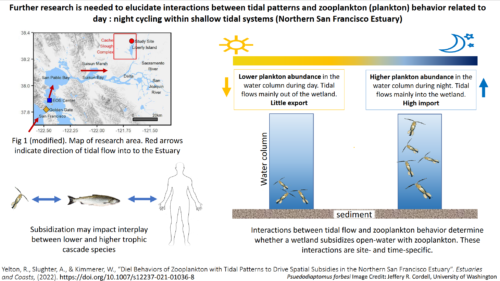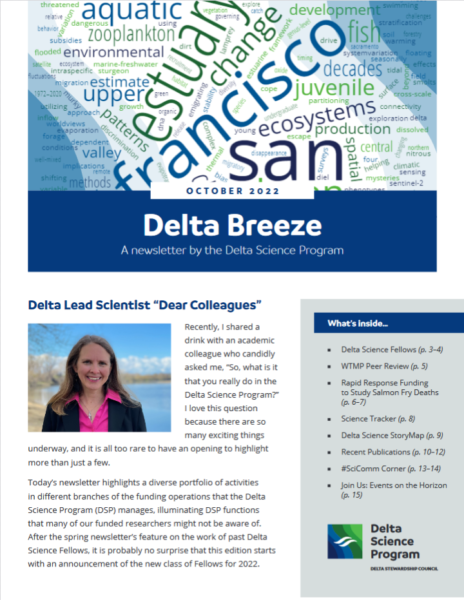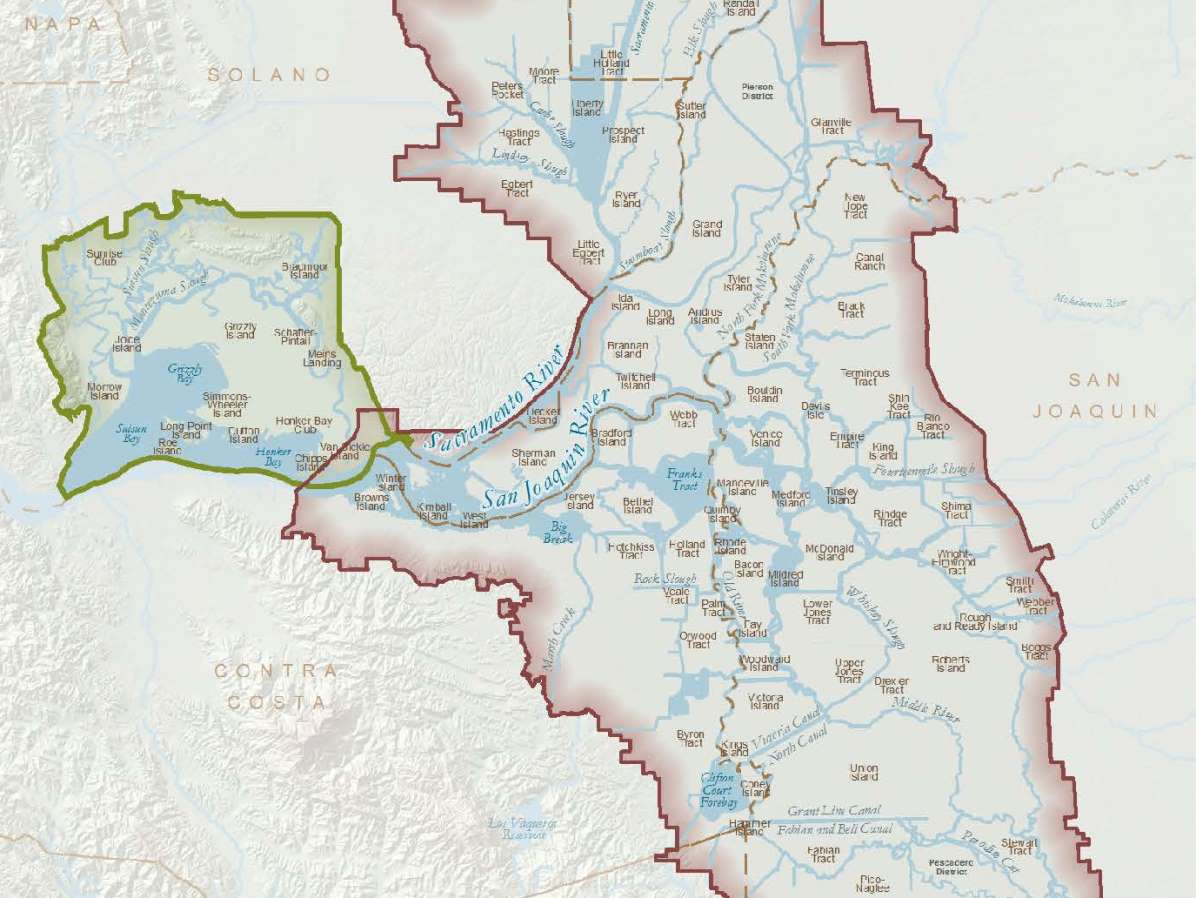At the October meeting of the Delta Stewardship Council, Lead Scientist Dr. Laurel Larsen highlighted Council-funded research that studied whether restored wetlands are importers or exporters of food to the system; she also updated the Council on the activities of the Delta Science Program. Then, Interagency Ecological Program Lead Scientist Steve Culberson briefed the Council on US Fish & Wildlife Service’s proposed listing of longfin smelt under the federal Endangered Species Act.
Article spotlight: Do wetlands export food to open water areas?
For the article spotlight, Dr. Larsen chose the paper, Diel Behaviors of Zooplankton with Tidal Patterns to Drive Spatial Subsidies in the Northern San Francisco Estuary, a product of research funded by the Council in 2018. The lead author was Rowan Yelton, with Anne Slaughter and Wim Kimmerer as co-authors.
 Habitat restoration in the Delta is done for several objectives, often within the same project. The most common objective is to support managed fish species by improving their habitat. This objective underlies much of the restoration plan through Eco Restore, the Delta Plan, and the voluntary agreements. One assumption in restoration planning is that wetland habitats generate food for fish that can be exported from the marsh by water flows to resource-scarce open water areas.
Habitat restoration in the Delta is done for several objectives, often within the same project. The most common objective is to support managed fish species by improving their habitat. This objective underlies much of the restoration plan through Eco Restore, the Delta Plan, and the voluntary agreements. One assumption in restoration planning is that wetland habitats generate food for fish that can be exported from the marsh by water flows to resource-scarce open water areas.
Food scarcity in open water is thought to be one of the factors leading to pelagic organism decline. Wetlands provide plant material and rich sources of carbon that fortify the food web from the bottom up; however, to make it to the open water, that food has to be transported away from the wetlands.
“The transport component is a factor often ignored in restoration planning or assumed,” said Dr. Larsen.
One possible transport mechanism is tidal dispersion and transport of materials, which could provide a means for those materials to be transported against the flow of the Delta’s rivers. Tidal pumping can essentially be thought of as the breathing of wetlands in and out, in and out. During flood tides, they receive an influx of sediment and nutrients; during ebb tides, they can transport food and carbon to the rest of the estuary.
But is this what actually happens? In their study, Yelton, Slaughter, and Kimmerer addressed that question. They focused on a small restored tidal marsh in the northern Cache Slough complex, part of the Liberty Island Conservation Bank created in 2010. They looked specifically at whether this wetland served as a net exporter of a species of copepod. This widely consumed zooplankton is an important part of the diet of many fish that swim in the open water. They partnered with the USGS to measure flows. And because the wetland was small, researchers could directly quantify the movement of copepods into and out of the marsh.
“What they found is a bit surprising,” said Dr. Larsen. “This wetland imported more of the copepods than it exported. So how can that be?”
“It really comes down to understanding the interactions between zooplankton behavior and tides. These copepods are not strong swimmers, so they’re at the mercy of flows for their horizontal movement. But they are effective at controlling their vertical movement in the water column. To avoid predators during the day, they hunker down at the bottom, but at night, they swim upward through the water column and forage for food. Flows are near zero at the very base of the water column, so the only time they’re moved around substantially by the tides is that night when they fill the water column.”
“The tidal pattern in the Cache Slough Complex right now is such that flood tides that fill up the marsh happen at night. So researchers found that net transport of these copepods was into the marsh, rather than out of it.”
Dr. Larsen pointed out that this finding is specific to this marsh at this moment in time. “But it does highlight an important message: we cannot automatically assume that marshes will generate significant quantities of food for fish in open water areas without accounting for that critical tidal dispersion component and how it interacts with the behavioral patterns of these food organisms.”
Activities of the Delta Science Program
2023 cohort of California Sea Grant state fellows: The Council is recruiting its 13th class of California Sea Grant Fellows. This year, the Council will add a fellow for a total of 5. Agency presentations were given, interviews have been conducted, and staff is awaiting the matching announcements.
 The October 2022 edition of the Delta breeze has been released: The quarterly Delta Breeze newsletter was released on October 4. The target audience is scientists, broadly speaking, and science managers. This edition contains an introduction to the 2022 class of Delta Science Fellows, an overview of the Water Temperature Modeling Program independent review panel, an overview of the Delta science tracker, and a list of 27 recent publications from science program staff and science program-funded researchers.
The October 2022 edition of the Delta breeze has been released: The quarterly Delta Breeze newsletter was released on October 4. The target audience is scientists, broadly speaking, and science managers. This edition contains an introduction to the 2022 class of Delta Science Fellows, an overview of the Water Temperature Modeling Program independent review panel, an overview of the Delta science tracker, and a list of 27 recent publications from science program staff and science program-funded researchers.
The newsletter also spotlights research on the emerging thiamine deficiency threatening Chinook salmon populations. “I would particularly call your attention to that article because it highlights one way in which Delta science program funded research has had an immediate, strong, and positive impact on hatchery fish management,” said Dr. Larsen.
Science for Communities Workshop: The Science for Communities workshop was held in the Big Break Visitor’s center in Oakley on October 6. At the workshop, representatives in the panel discussions included a diverse range of scientists and community members, such as the California Indian Environmental Alliance, Sacramento Regional Coalition to End Homelessness, Sustain our Abilities, public health advocates, Restore the Delta, and Little Manila Rising. An upcoming workshop report is forthcoming.
Social Science Community of Practice: Annual Symposium: The Social Science Community of Practice held its annual symposium focusing on advancing interdisciplinary research. It was a two-day event, with the first day featuring various speakers talking about social science methods and how they were used to advance understanding of complex socioecological systems elsewhere. The second day featured interdisciplinary breakout groups, which discussed collaboration on projects that would advance the Science Action Agenda. The hope is that the workshop will generate proposals for upcoming competitive solicitations. A more detailed report will be presented at a future meeting.
Harmful Algal Bloom Workshop: The harmful algal bloom workshop is scheduled for November 8-9. It will be a hybrid workshop. Assemblymember Bill Quirke, who authored Assembly Bill 834 to establish a freshwater and estuarine Harmful Algal Bloom program, will provide opening remarks.
Salinity Management Workshop: Focused working group meetings are planned for later this fall to continue to gather feedback on the demonstration exercise that will evaluate how structural modifications to the Delta, including nature-based solutions and the use of barriers, play out over long periods with extended drought and sea level rise. In addition, the social science team will undertake a formal analysis to map out different perspectives related to salinity management in the Delta. This is important because it establishes a baseline and it allows us to potentially quantify how those perspectives might change through participation in a collaborative planning process. More information will be available soon.
US FWS proposes listing longfin smelt as endangered
Dr. Steve Culberson, the lead scientist for the Interagency Ecological Program, provided an update on the U. S. Fish and Wildlife Service’s proposal to list the longfin smelt as an endangered species under the federal Endangered Species Act.
The Interagency Ecological Program or IEP has been tasked with monitoring the status and trends of various fish and aquatic species associated with the San Francisco Estuary and the potential impacts of the federal and state water projects since 1970.
Various runs of Chinook salmon were listed as state and federal endangered species in 1989 and 1994. The Delta smelt was listed as threatened by the US Fish and Wildlife Service and the Department of Fish and Wildlife in 1993. Programs have been established within the IEP to track and document habitat features associated with these and other species of management interest, and several long-term programs have been collecting information about species of concern. IEP resources have been used to help determine the status and options supporting the recovery of estuarine fish species, including the longfin smelt, which was listed by the state as a threatened species in 2009.
The US Fish and Wildlife Service recently announced they propose listing the San Francisco Bay-Delta population segment of the longfin smelt as endangered. The species was considered “warranted but precluded” for listing since 2012; however, concern over the status of the species remains. Therefore, the Service is now reconsidering the listing. The public comment period will close on December 6, 2022.
The Service thoroughly reviewed the Bay-Delta population of longfin smelt, its habitat, and current threats to determine whether Endangered Species Act protections were warranted. Habitat loss due to the long-term reduction and alteration of freshwater flows into the San Francisco Bay estuary is the primary threat. Longfin smelt requires specific water temperatures and adequate freshwater flows to survive.
The Department of Water Resources and the Department of Fish and Wildlife have already articulated a science plan for pursuing actions to understand what drives longfin smelt population abundance and to support recovery. They have formally adopted a schedule to implement the science plan as terms in the incidental take permit issued in 2020 for long-term operations of the State Water Project.
Current State protections for longfin smelt prohibit possession, purchase, sale, and take of the species; federal protections would extend to habitats as well as to individuals of the species.
“Steps to protect pelagic or open water areas of the Delta near water project and other diversions could include specific diversion curtailments similar, but add to those already in place for delta smelt,” said Dr. Culberson. “The IEP is piloting additional monitoring, modeling, and analysis activities that will aid in understanding impacts to and the potential recovery of longfin smelt. Regardless of the pending US Fish and Wildlife Service listing decision, additional recovery actions could be taken as the result of any US Fish and Wildlife Service decision to list the longfin smelt as endangered.”



